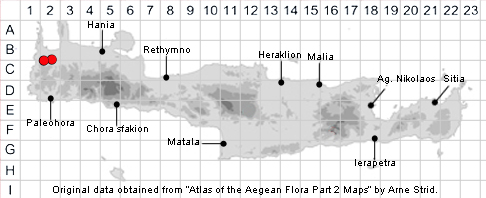SPECIES DESCRIPTION
DIANTHUS XYLORRHIZUS
Family and Genus:- CARYOPHYLLACEAE/Subgen. DIANTHUS
Common Names:- None
Homotypic Synonyms:- None
Meaning:- Dianthus (Gr) Zeus'-flower. a name used by the Greek philosopher
Theophrastus.
Xylorrhizus (Gr) Woody-rooted.
General description:- Perennial.
Stems:-
1) 10-25 cm, Woody and branched at the base, forming a lax cushion of
moderately short leafy shoots.
2) Flowering stems several, (-2)-flowered.
Leaves:-
1) In opposite pairs, those on sterile shoots 12-30 x c. 2 mm, thin, somewhat
flaccid.
a) basal, more than 1 mm wide, flat and rather soft.
b) cauline, like those on sterile shoots but smaller; sheaths very short.
Flowers:-
1) Epicalyx scales, 4, 1/4~1/3 as long as the calyx, mucronate, coriaceous, pale
brownish.
2) Calyx, 24-26 x 5-7 mm including teeth, widest below middle, pale-striate; teeth
3-6 mm, oblong-lanceolate, acute at the apex.
3) Petal-limb, spreading, -10 mm, obovate-cuneate, toothed at the apex, white on
the upper surface, tinged green on the reverse.
4) Styles, coiling.
5) Stamens, recurved to the petal limb.
Fruit:-
1) Capsule. dehiscing apically with 4 teeth, carpophore often present.
2) Seeds.numerous, concave on 1 side.
Key features:-
1) Epicalyx-scales, brown, coriaceous.
2) Basal leaves, more than 1 mm wide, flat and rather soft.
3) Petal-limb, 4-6 mm, dirty white.
Habitat:- A chasmophyte of calcareous cliffs and rock crevices, at altitudes of 300-
700 m.
Distribution:- A rare local endemic of W Crete.
Flowering time:- Apr-June.
Photos by:- Fotis Samaritakis
Status:-
Conservation status (for threatened species): Vulnerable (V) according to the Red
Data Book of Rare and Threatened Plants of Greece (1995).
Vulnerable (V) according to IUCN 1997.
Protection status (for threatened species): Greek Presidential Decree 67/1981.
